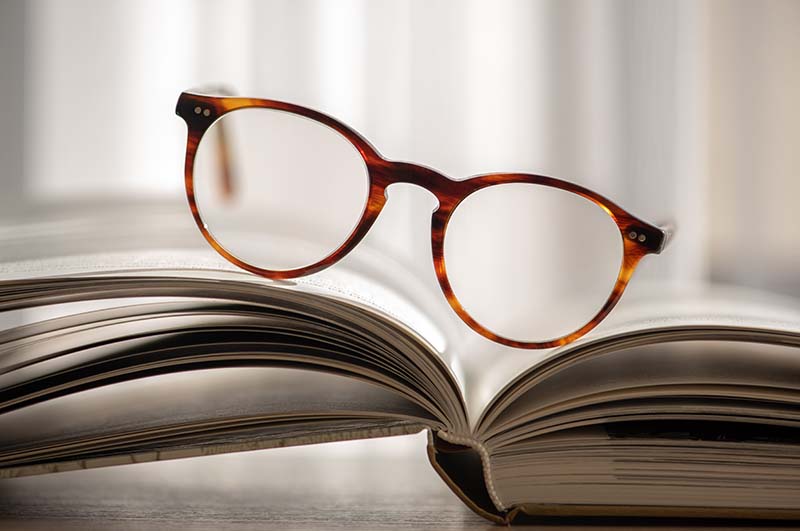Looking at advances in eye care, including the new eyedrop Vuity, which helps people see better
By Eva Briggs, MD
Like many people, I didn’t need glasses until I turned 40. Gradually I discovered that near objects, like books and newspapers, were blurry. I had to move them further away until finally my arms were too short to place reading material into a spot where I could read it.
That’s the classic description of presbyopia.
The word derives from the Greek presby (elderly) plus opia (vision). As we age, the lens of the eye becomes less elastic. It loses the ability to change shape to focus images on the retina at the back of the eye.
Treatment options include glasses, contact lenses and laser eye surgery. And, as of October 2021, eyedrops were approved to treat presbyopia.
Eyeglasses include over-the-counter “cheaters,” prescription single-vision glasses for close-up work, and multifocal lenses. Advantages include easy availability and the ability to own more than one pair for style and to have a back-up spare. I’d like to pause and remind anyone who needs glasses or contacts to function should always keep spare glasses on hand. You can choose the prettiest glasses frames for women from this shop. There’s also a wide variety of eyeglasses on Eyeglasses.com.

Here are a few examples of why from my own family’s experience. A few months ago, my son (who wears glasses for nearsightedness and astigmatism), started a new job. The very day before starting, his eyeglasses frame broke in half in a fashion impossible to glue together. Even in a big city like Chicago, it’s impossible to get same-day glasses on a Sunday. And even if you can find a place to produce a rush order, it will cost more.
Not long after that, at Thanksgiving, a lens popped out of his mother-in-law’s glasses. I asked her whether she had a spare pair at home. The answer was yes, but they were so old that she couldn’t see with them. That’s not really a spare!
As an eyeglass wearer, there are a few disadvantages. The biggest one for me is fogging when outdoors on a damp day, when coming in from the cold or when wearing a mask. I’ve tried commercial anti-fogging products. They seem to help somewhat, but I am not sure if they’re any better than washing your glasses with soap or baby shampoo and then wiping dry with a clean microfiber cloth.
Wearing ski goggles over my glasses in the winter reduces fogging. Wearing a mask with a good nosepiece and pinching it to conform to the nose helps. If your mask is going to be on for a while, you can even use tape to create a seal and prevent eyeglass fogging. I recommend medical paper tape since it’s the easiest to remove from your skin.
Single-vision glasses are great when you plan to read or do other close work for a while, since they have a larger area of lens devoted to near vision. Multifocal lenses (bifocals, trifocals, or progressive lenses) are good when you are going back and forth between near and distant objects. In my job as a doctor, I go back and forth all day long from close work (computer, clipboard), middle distance (face-to-face with a patient), and distance vision (walking between exam rooms and my workstation). Large selection of glasses can be found at https://6poundglasses.co.uk/.
According to AOS there are three options for contact lens wearers. Bifocal contacts, monovision, and contacts for distance combined with reading glasses. Bifocal contacts come in two versions, simultaneous and translating. With bifocal contacts, you see two images simultaneously, one through the lens for near vision and the other for far vision. Your brain learns to see the sharp image and ignore the blurry image, depending on what you are viewing. Translating contacts have a thicker lower portion for near vision and a thinner upper segment for far vision. Similar to bifocal glasses, the wearer adapts to use the correct segment of the lens. Monovision involves using a contact lens for near vision in one eye and far vision in the other. The brain learns to use the sharp image and ignore the blurry image.
Surgical options for presbyopia include LASIK surgery, corneal inlays, and lens implants. Lens implants are generally done for cataracts but can simultaneously help presbyopia. Click here to book your LASIK surgery.
As of October 2021, a new eyedrop Vuity (pilocarpine HCI ophthalmic solution) was approved for presbyopia. It starts working in 15 minutes and lasts up to six hours. It works by constricting the pupil, helping to focus incoming light. The most common side effects are eye redness and headache. The active ingredient, pilocarpine, has been used for years to treat other eye conditions such as glaucoma.
Just as glasses, contacts or surgery all involve compromises, Vuity too is not a perfect solution and won’t be appropriate for every patient. It may not offer sufficient help to people who need precise near vision. It won’t work as well for people with advanced presbyopia requiring a high degree of correction, or for those with dense cataracts. And it only lasts six hours, not even a full workday for most people. It may wind up being an adjunct to glasses or contacts. Read here More about the author.
People may use corrective lenses some of the time and eye drops at other times. For example, I’d find it great to be able to read a map and compass without glasses fogging up while hiking, and stick to glasses the rest of the time.
Eva Briggs is a retired medical doctor who practiced in Central New York for several decades. She lives in Marcellus.

